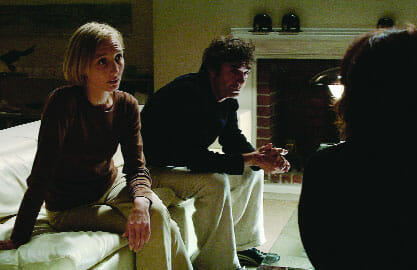
(Above [L-R]: Nathalie Richard and Daniel Duval)
Thriller of an art film fascinates on every level
Director/Writer: Michael Haneke
Cinematography: Christian Berger
Starring: Daniel Auteuil, Juliette Binoche
Studio info: Sony Pictures Classics, 121 mins.
A filmmaker who wants to engage the minds of an audience must perform a balancing act. The movie needs to give viewers enough leeway to apply their own thoughts and enough guidance to generate some thoughts in the first place. Michael Haneke’s aptly named Caché (Hidden) is that kind of movie—a multi-layered, open-ended thriller, an onion sliced by taut piano wire.
Georges (Daniel Auteuil), Anne (Juliette Binoche) and their pre-teen son Pierrot should be living a comfortable life, but someone is leaving bizarre videotapes and crude drawings on their doorstep. The tapes themselves are so mundane they’re creepy, and Haneke conveys this with some trickery. Early in the film, he lets an exterior shot of the family’s Parisian house continue so long we wonder if anything is going to happen, or if it already has and we missed it. When the scene halts and rewinds, we realize we’re actually watching one of the tapes, and Georges and Anne are wondering the same thing we are: what are they supposed to see aside from their own house?
Throughout Caché, Haneke slips easily between the two poles—live and Memorex—without immediately clarifying which one he’s leaning against. In a particular scene that’s (presumably) not on videotape, something shocking happens, and we expect the camera to pull away just after the action peaks. But it doesn’t. It keeps watching uncomfortably, without music, like a security camera that never blinks. Another scene, a flashback, is shot at a distance from the action, but a nasty-looking axe sits so deliberately in the foreground that it’s clearly evidence of a controlling force behind the camera; maybe this is a bad memory shaped by a guilty conscience and set forever in the head.
Watching Caché feels like an exercise in seeing, like Michelangelo Antonioni’s movies of the ’60s and ’70s, especially Blow Up and the amazing climax of The Passenger, where important details seem hidden in the picture if only we knew where to look. The difference is that Georges and Anne would rather not look at all, but someone forces them to.
Georges suspects an Algerian man named Majid (Maurice Bénichou)—whom his parents adopted when he was young—sent the tapes. But who sent them is less important than Georges’ suspicion of who sent them because it opens the door to an episode buried in his past. He doesn’t tell Anne or Pierrot much about his theory, but keeping secrets is part of this family’s daily routine. In the short time the movie spans, we see them cover up so many things, big and small, like a reflex, that we wonder how tall the pile of lies, half-truths and omissions already stood before the cameras began rolling.
The film can be viewed from many different perspectives, not as a frustrating collage of underdeveloped threads like Traffic or Syriana but as one versatile metaphor. It’s the story of a family with blocked communication channels. It’s a look at the way buried trauma seeps into daily life. And it’s an examination of fear and vulnerability so palpable that a long sequence—in which Georges simply enters the house, draws the curtains and lies down for a nap—drips with dread. A friend who attended the same screening I did saw a theme of national guilt in the story about a Frenchman who has a damaged relationship with his Algerian brother; after all, the Algerian war hangs over France the way the Vietnam war hangs over America. Expand the analogy further and you have a Western man’s fear of an Arab with whom he shares a complicated past.
Despite these provocative layers, Haneke develops the themes in concrete terms so Caché also works as good-old-fashioned suspense. He works against the genre in one way; he’s more interested in the mystery’s existence than in solving it, leaving plenty of room in his fertile construction to accommodate the intelligence of his audience.